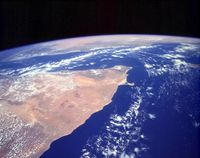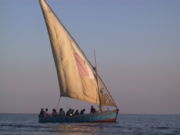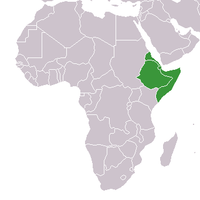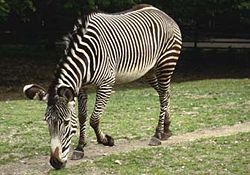Horn of Africa
2008/9 Schools Wikipedia Selection. Related subjects: African Geography
The Horn of Africa (alternatively Northeast Africa, and sometimes Somali Peninsula) is a peninsula of East Africa that juts for hundreds of kilometers into the Arabian Sea, and lies along the southern side of the Gulf of Aden. It is the easternmost projection of the African continent. The term also refers to the greater region containing the countries of Eritrea, Djibouti, Ethiopia and Somalia. As such, it covers approximately 2,000,000 km² (772,200 sq mi) and is inhabited by about 90.2 million people (Ethiopia: 75 million, Somalia: 10 million, Eritrea: 4.5 million, and Djibouti: 0.7 million).
Geography and climate
The Horn of Africa is almost equidistant from the equator and the Tropic of Cancer. It consists chiefly of mountains uplifted through the formation of the Great Rift Valley, a fissure in the Earth's crust extending from Turkey to Mozambique and marking the separation of the African and Arabian tectonic plates. Most of the region is mountainous due to faults resulting from the Rift Valley, with the highest peaks in the Simien Mountains of northwestern Ethiopia. Extensive glaciers once covered the Simien and Bale Mountains, but melted at the beginning of the Holocene. The mountains descend in a huge escarpment to the Red Sea and more steadily to the Indian Ocean. Socotra is a small island in the Indian Ocean off the coast of Somalia. Its size is 3,600 km² (1,390 sq mi) and it is a territory of Yemen, the southernmost country on the Arabian peninsula.
The lowlands of the Horn are generally arid in spite of their proximity to the equator. This is because the winds of the tropical monsoons that give seasonal rains to the Sahel and the Sudan blow from the west. Consequently, they lose their moisture upon reaching Djibouti and Somalia, with the result that most of the Horn receives little rainfall during the monsoon season. On the windward side in the west and centre of Ethiopia, and the extreme south of Eritrea, monsoonal rainfall is heavy. In the mountains of Ethiopia, many areas receive over 2,000 mm (78 in) per year, and even Asmara receives an average of 570 mm (23 in). This rainfall is the sole source of water for many areas far from Ethiopia, most famously for Egypt, which — in terms of rainfall — is the driest nation on Earth.
In the winter, the northeasterly trade winds do not provide any moisture except in mountainous areas of northern Somalia, where rainfall in late autumn can produce annual totals as high as 500 mm (20 in). On the eastern coast, a strong upwelling and the fact that the winds blow parallel to the coast means annual rainfall can be as low as 51 mm (2 in).
Temperatures on the Red Sea coast are some of the hottest in the world, typically around 41°C (106°F) in July and 32°C (90°F) in January. On the east coast, owing to the upwelling, they are somewhat, cooler but still hot. As elevation increases, temperatures decrease, so that at Asmara, maxima are around 20°C (68°F), though frosts are frequent on cloudless nights. On the highest peaks of the Simien Mountains, however, temperatures rarely reach 14°C (57°F) and can be as low as –10°C (14°F) on cloudless nights.
History
Ancient history
The Kingdom of Aksum (also known as "Axum") was an ancient state located in modern-day Ethiopia, Eritrea, northern Somalia and Yemen that thrived between the 1st and 7th centuries. Due to the Horn's strategic location, it has been used to restrict access to the Red Sea in the past.
The region was also a source of biological resources during the Antiquity: The Ancient Egyptians, Greeks and Romans sent expeditions to the region for frankincense, myrrh, dragon's blood or cinnabar and took these commodities back along the Incense Route. Therefore the Romans called this region Regio Aromatica. It is believed to also contain the fabled Egyptian Land of Punt.
The Horn was also part of a network of ports that extended down the coast of Africa, from the Persian Gulf as part of a larger and ancient commerce route along the greater Indian Ocean rim.
Modern history
In recent decades, the Horn of Africa has been a region continuously in crisis. Ethiopia occupies a predominant position in the Horn because of its demographic importance: about 85% of the area's population live in this country. Large parts of the Horn of Africa were colonized by Italy: Eritrea (1880-1941), the Italian Somaliland protectorate (1890-1960) and a brief occupation of Ethiopia (1936-1941). Britain established in North Somalia ( British Somaliland) and France in Djibouti (French Somaliland). Yet Ethiopia's history is largely marked by conflicts between Muslims and Christians for resources and living space, as well as between nationalism and Marxism-Leninism in modern times. The rest of the region also faces several concurrent problems: Somalia is still caught up in a civil war which first began in the late 1980's, while Ethiopia and Eritrea regularly clash.
Moreover, the region is regularly stricken by natural catastrophes, such as droughts or floods that hit rural areas particularly hard. As a result, the region has some of the world's highest levels of malnutrition and is continuously threatened with a major humanitarian crisis. Between 1982 and 1992, about two million people died in the Horn of Africa due to this combination of war and famine.
Since 2002 The Horn of Africa has been a major focus of attention by the United States, France, Germany, and eleven African nations regarding the War on Terrorism.
Culture and ethnicity
The countries of the Horn of Africa are culturally linked together. Local people have been using the plow for cultivation and kept the Arabian dromedary as domestic animals for a long time and for the most part represent a unique cultural and racial bloc on the continent.
Some important ethno-linguistic groups in the Horn of Africa are:
- In Djibouti: the Afar (Danakil) and the Somali (Issa)
- In Eritrea: the Bilen, the Afar, the Hedareb ( Beni-Amer/ Beja), the Kunama (Baza), the Nara (Nialetic), the Saho (Irob), the Rashaida, the Tigre, and the Tigrinya. The Jebertis are Muslim Tigrinyas who consider themselves as a separate ethnicity, but are not recognized by other sources.
- In Ethiopia: Amharas, Afars, Agaw groups, Gurages, Hamers, Hararis (also Hadere or Adere), the Irob (Catholic Sahos), Sidamas, Oromos, Saho, Somali, Tigrayans, as well as many other small groups (see also ethnicities listed at Southern Nations, Nationalities, and People's Region) .
- In Somalia: the Somali
Economy
States of the region depend largely on a few key exports:
Ecology
The Horn of Africa is a UNESCO Biodiversity Hotspot and one of the two entirely arid ones. However the Horn of Africa suffers largely from overgrazing and only 5% of its original habitat still remains. On Socotra, another great threat is the development of infrastructure.
Fauna
About 220 mammals are found in the Horn of Africa. Among threatened species of the region, we find several antelopes such as the beira, the dibatag, the silver dikdik and the Speke’s gazelle. Other remarkable species include the Somali wild ass, the desert warthog, the Hamadryas Baboon, the Somali pygmy gerbil, the ammodile, and the Speke’s pectinator. The Grevy's zebra is the unique wild equid of the region.
Some important bird species of the Horn are the Bulo Burti boubou, the golden-winged grosbeak, the Warsangli linnet, or the Djibouti Francolin.
The Horn of Africa holds more endemic reptiles than any other region in Africa, with over 285 species total (and about 90 species found exclusively in the region). Among endemic reptile genera, there are Haackgreerius, Haemodracon, Ditypophis, Pachycalamus and Aeluroglena. Half of these genera are uniquely found on Socotra. Unlike reptiles, amphibians are poorly represented in the region.
There are about 100 species of freshwater fish in the Horn of Africa, about 10 of which are endemic. Among the endemic, we find the cave-dwelling Somali blind barb and the Somali cavefish.
Flora
It is estimated that about 5,000 species of vascular plants are found in the Horn, about half of which are endemic. Endemism is most developed in Socotra and Northern Somalia. The region has two endemic plant families: the Barbeyaceae and the Dirachmaceae. Among the other remarkable species, there are the cucumber tree found only on Socotra (Dendrosicyos socotrana), the Bankoualé palm, the yeheb nut, and the Somali cyclamen.




